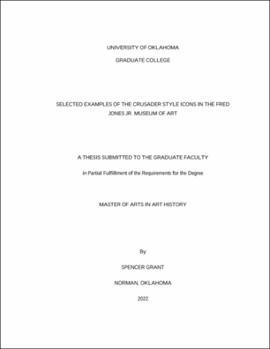| dc.contributor.advisor | Basic, Rozmeri | |
| dc.contributor.author | Grant, Spencer | |
| dc.date.accessioned | 2022-12-09T19:38:28Z | |
| dc.date.available | 2022-12-09T19:38:28Z | |
| dc.date.issued | 2022-12-16 | |
| dc.identifier.uri | https://hdl.handle.net/11244/336907 | |
| dc.description.abstract | Before Constantinople fell in 1453, Byzantine-style iconography had been experiencing massive shifts in not only production, but also in manufacturing quantity and personal use. Two such pieces reminiscent of this shift are displayed in the Fred Jones Jr. Museum of Art as part of the Ambassador George Crews and Cecilia DeGoyler McGhee Collection of Icons at the Fred Jones Jr. Museum of art at The University of Oklahoma at Norman. These two works, Virgin and Child, Virgin of Consolation (Madonna della Consolazione) and The Virgin as the Life-Giving Spring are representative of the aforementioned variables, namely the effects of Crusaders and their art on the iconological canon, the emergence and prevalence of icons hailing from the Greek Ionian islands, and the influence of private patronage on thematic matter and function. By creating a historiographical timeline focusing on the influence of these variables of style, I identify the icons in the FJJMC as derivates of the works being manufactured around the thirteenth to fifteenth centuries | en_US |
| dc.language | en | en_US |
| dc.subject | byzantine | en_US |
| dc.subject | byzantine art | en_US |
| dc.subject | crusades | en_US |
| dc.subject | medieval art | en_US |
| dc.title | Selected examples of the Crusader style icons in the Fred Jones Jr. Museum of Art | en_US |
| dc.contributor.committeeMember | Palmer, Allison | |
| dc.contributor.committeeMember | Karathanasis, Constantinos | |
| dc.date.manuscript | 2022-12-07 | |
| dc.thesis.degree | Master of Arts in Art History | en_US |
| ou.group | Weitzenhoffer Family College of Fine Arts::School of Visual Arts | en_US |
